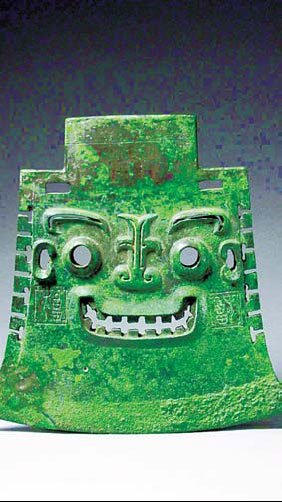Heritage
A bronze battle-axe that evokes a smile
Updated: 2011-03-29 07:54
By Zhang Zixun (China Daily)
EDITOR's Note: Every week we look at a work of art or a cultural relic that puts the spotlight on China's heritage.
|
The Ya Chou bronze battle-axe at Shandong Museum. Provided to China Daily |
The on-going exhibition, The Art of Chinese Bronze Wares, at the National Museum of China, offers not just a peek into ancient Chinese civilization, but also a rare look at the sense of humor of its ancient creators.
Take the Ya Chou bronze battle-axe, for example.
Excavated in 1965 from the No 1 Subutun Shang Tomb in Qingzhou, Shandong province, and now kept in Shandong Museum, this bronze battle-axe of the Shang Dynasty (16th century-11th century BC), is 32.7 cm long and 34.5 cm wide, and features a human face with exaggerated features such as bow-shaped eyebrows, round eyes, elliptical ears, a bull-shaped nose, and a wide-open mouth full of sharp teeth.
"This style is consistent with other bronze wares of the Shang Dynasty, that are both majestic and scary," says Lu Wensheng, head of Shandong Museum.
As one of the 18 weapons of ancient times and commonly used by the king, the battle-axe stood for power and justice.
This also explains why the Chinese character for "king" found on bone inscriptions resembles the shape of the battle-axe.
Another bronze battle-axe was also excavated at the same time from the No 1 Subutun Shang Tomb, the largest and best Shang tomb after the Tomb of Shang Kings in Anyang, Henan province.
Now kept at the National Museum of China, this battle-axe also has a human face like the Ya Chou, except the eyes and nose are shaped differently and the mouth is even bigger.
These two bronze battle-axes are the only ones found in China with an openwork carving of a human face.
 |
Another key difference between the two is that there are four symmetrical pictographic inscriptions of "Ya Chou" carved under the two ears on both sides of the Ya Chou battle-axe, while there is none on the other one. The inscription is also the reason the battle-axe is called "Ya Chou".
Guo Moruo (1892-1978), Chinese author, poet, historian, archaeologist and an expert on ancient writing, believed that Ya Chou was the title of an ancient nation that existed in the Xia Dynasty (21st century-16th century BC) or even earlier.
It is believed the human face on the Shang Dynasty battle-axe was intended to scare the enemy. But it is hard to say how effective that strategy was.
Gazing at it in the 21st century, one is more amused than scared, a feeling that also seems reflected in the upturned corners of the mouth of the image.
Specials

Fill dad's shoes
Daughter and son are beginning to take over the family business of making shoes.

Have you any wool?
The new stars of Chinese animation are edging out old childhood icons like Mickey Mouse and Hello Kitty.

Virtual memorial
High-Tech touches to traditional tombsweeping festival help environment
